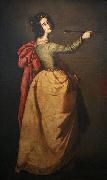Wholesale Oil Painting No Minimum |
|||||||||||
|
|
|||||||||||

|
|||||||||||
|
|
|
||||||||
Francisco de Zurbaran1598-1664 Spanish Francisco de Zurbaran Galleries Spanish baroque painter, active mainly at Llerena, Madrid, and Seville. He worked mostly for ecclesiastical patrons. His early paintings, including Crucifixion (1627; Art Inst., Chicago), St. Michael (Metropolitan Mus.), and St. Francis (City Art Museum, St. Louis), often suggest the austere simplicity of wooden sculpture. The figures, placed close to the picture surface, are strongly modeled in dramatic light against dark backgrounds, indicating the influence of Caravaggio. They were clearly painted as altarpieces or devotional objects. In the 1630s the realistic style seen in his famous Apotheosis of St. Thomas Aquinas (1631; Seville) yields to a more mystical expression in works such as the Adoration of the Shepherds (1638; Grenoble); in this decade he was influenced by Ribera figural types and rapid brushwork. While in Seville, Zurbur??n was clearly influenced by Velazquez. After c.1640 the simple power of Zurbaran work lessened as Murillo influence on his painting increased (e.g., Virgin and Child with St. John, Fine Arts Gall., San Diego, Calif.). There are works by Zurbar??n in the Hispanic Society of America, New York City; the National Gallery, Washington, D.C.; and the Philadelphia Museum of Art.. |
||||||||
|
|
||||||||
Saint Ursula
Saint Ursula Painting ID:: 82940 |
Saint Ursula, Francisco de Zurbaran, 1650. Oil on canvas. Bought in 1893.
cjr Saint Ursula, Francisco de Zurbaran, 1650. Oil on canvas. Bought in 1893. cjr |
|||||||
|
|
||||||||
|
GRAMATICA, Antiveduto Italian Baroque Era Painter, 1571-1626 Italian painter. He was from a Sienese family. According to Baglione, his parents were journeying from Siena to Rome when his mother went into labour and gave birth to him at an inn, an inconvenience that had been foreseen ('antiveduto') by his father and led to his unusual name. For a brief period he was a pupil of Giandomenico Angelini ( fl 1550-1600), under whom he painted small-scale works, mainly on copper. His prolific production of devotional paintings, portraits and copies of portraits won him swift success; in 1593 he became a member of the Accademia di S Luca and in 1604 of the Congregazione dei Virtuosi. His early portraits have not been identified; they included highly popular copies of a series of Famous Men then at the Villa Medici, works that Caravaggio probably also copied when he worked for some months in his studio on his arrival in Rome in 1592 Saint Ursula 1650. Oil on canvas cyf |
||||||||
|
|
||||||||
|
Prev Next
|
||||||||
|
|
||||||||
|
Related Paintings to GRAMATICA, Antiveduto :. |
||||||||
|
|
||||||||
|
CONTACT US |

